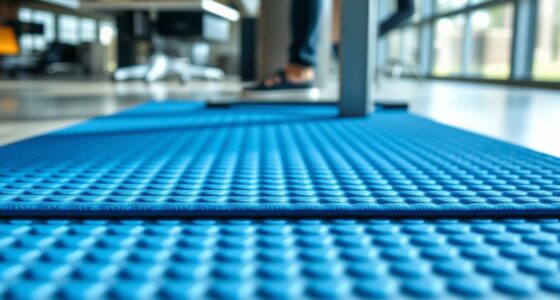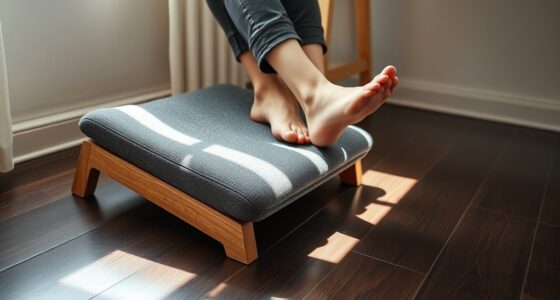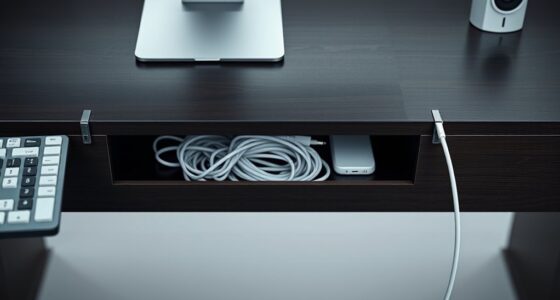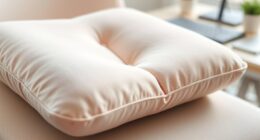Balance boards can boost your posture, core strength, and movement at your standing desk, making it a healthier way to work. They require careful choice to match your workspace and safety needs, but with proper use, they can reduce discomfort and encourage active sitting. However, they may take time to master and aren’t suited for everyone. To discover how to choose and use one effectively, keep exploring the details ahead.
Key Takeaways
- Balance boards can improve core strength and posture when used properly at a standing desk.
- They help break up long sitting periods, promoting movement and reducing sedentary health risks.
- Proper safety precautions and ergonomic adjustments are essential to prevent falls or strain.
- Different types and materials suit various stability needs and workspace environments.
- Regular, gradual use enhances benefits while minimizing fatigue and injury risks.
What Are Balance Boards and How Do They Work?

Balance boards are simple, unstable platforms designed to challenge your stability while standing. Their ergonomic design promotes active engagement of your core muscles, helping improve balance stability over time. These boards typically feature a flat surface on top and a rounded or cylindrical base underneath, creating a rocking motion that requires constant adjustments. When you stand on a balance board, you naturally shift your weight to maintain equilibrium, which enhances proprioception and coordination. The instability encourages subtle movements, strengthening muscles that support your posture. By focusing on maintaining balance, you train your body to stabilize itself more effectively. Some balance boards incorporate self-stabilizing features, which help users maintain balance more easily during use. Balance boards are straightforward tools that work by leveraging your body’s natural reflexes, making them an effective way to boost balance stability during your work or workout routines.
The Benefits of Using a Balance Board at Your Desk

Using a balance board at your desk can boost your core strength and improve your stability throughout the day. It encourages you to maintain an active posture, preventing slouching and discomfort. Plus, it helps reduce the health risks associated with prolonged sitting, keeping you more energized and focused. Incorporating a balance board can also enhance your overall posture and alignment, contributing to long-term musculoskeletal health.
Enhances Core Strength
When you stand on a balance board at your desk, engaging your core muscles becomes a natural part of maintaining stability. This constant core activation helps strengthen the muscles that support your spine and improve overall stability. As you balance, your abdominal, back, and oblique muscles work together to keep you upright, increasing muscle engagement over time. This continuous effort not only boosts your core strength but also enhances your posture and prevents fatigue. Using a balance board challenges your muscles in a dynamic way, promoting muscle endurance and stability. Over days and weeks, this consistent activation leads to a more resilient core, making everyday movements easier and reducing the risk of strain or injury. Incorporating wall organization systems can further support your ergonomic workspace and encourage proper posture during extended standing periods.
Promotes Active Posture
Standing on a balance board encourages you to maintain an active, upright posture throughout your workday. This promotes ergonomic benefits by engaging core muscles and aligning your spine properly. As you balance, you naturally correct slouching and reduce strain on your neck and shoulders. Consistent use helps reinforce good posture habits, making them second nature even without the board. To visualize, consider this table:
| Posture Aspect | How Balance Boards Help | Result |
|---|---|---|
| Core Engagement | Activates stabilizer muscles | Supports upright posture |
| Spinal Alignment | Encourages proper positioning | Reduces discomfort |
| Muscle Activation | Promotes active sitting | Prevents slouching |
| Ergonomic Benefits | Improves overall sitting ergonomics | Less fatigue |
Using a balance board actively promotes posture correction, fostering healthier work habits.
Reduces Sedentary Risks
Ever wondered how to combat the health risks of prolonged sitting at your desk? Using a balance board with an ergonomic design helps you stay active and break up long periods of inactivity. By engaging stabilizing muscles, you reduce the risks associated with sedentary behavior, like poor circulation and metabolic issues. Incorporating safety precautions, such as choosing a non-slip surface and maintaining proper posture, to prevent falls or injuries. The dynamic movement encourages you to shift weight naturally, boosting circulation and calorie burn throughout your workday. This simple addition transforms your desk setup into a tool for healthier habits, making it easier to stay active without leaving your workspace. Additionally, understanding greenhouse construction can inspire ergonomic setups that foster better posture and movement in your environment. Ultimately, a balance board can considerably lower sedentary risks while supporting your overall well-being.
Common Types of Balance Boards and Their Features
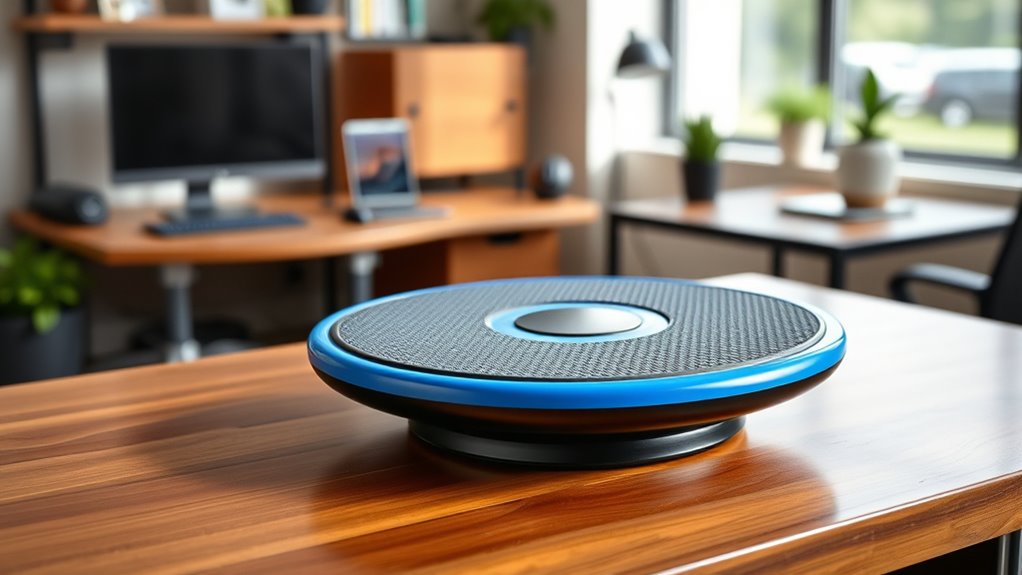
When choosing a balance board, you’ll notice options like rigid or inflatable types, each offering different stability and portability. Rocker and wobble designs provide varied movement patterns to challenge your balance in different ways. Material and surface options also affect grip and durability, so consider what best suits your workspace and comfort needs. Incorporating home decoration inspiration can help create a more inviting and motivating environment for your balance exercises.
Rigid vs. Inflatable Types
Choosing between rigid and inflatable balance boards depends on your specific needs and preferences. Rigid boards often feature sleek aesthetic designs, making them look modern and professional on your desk. They provide a stable surface, ideal for those seeking consistent balance training or focusing on stability. Inflatable balance boards tend to have a more casual, playful look, which might suit a creative or relaxed workspace. They are usually more portable and easier to store. When considering price comparison, inflatable options are generally more affordable, but rigid boards can be pricier due to their durable materials. Your choice hinges on whether you prioritize style, stability, portability, or budget. Additionally, safety considerations should influence your decision, especially if you plan to use the board frequently or for extended periods. Both types can enhance your posture and engagement, so select the one that fits your workspace and personal preference best.
Rocker vs. Wobble Designs
Rocker and wobble designs are two popular styles of balance boards that cater to different training goals and preferences. The rocker board features a curved, stable base that tilts side to side, offering smooth, controlled movements. It emphasizes ergonomic benefits by helping improve posture and core stability without excessive instability. Wobble boards, on the other hand, have a rounded or spherical surface that allows multidirectional movement, engaging more muscles and enhancing balance. Their design aesthetics often appeal to those seeking a dynamic look and versatile use. If you prefer a more stable, ergonomic workout, a rocker board may suit you best. For those wanting a challenging, engaging experience, wobble designs provide greater instability and variety. Both styles can complement your standing desk setup effectively. Additionally, multidirectional movement can lead to increased muscle activation and improved coordination, making wobble boards a versatile choice for active users.
Material and Surface Options
Balance boards come in a variety of materials and surface designs, each offering distinct benefits depending on your training goals and environment. Wooden boards provide durability and natural ergonomics, while plastic options are lightweight and easy to clean. Surfaces with textured grips enhance safety precautions by reducing slips, and smooth surfaces promote fluid movement, improving ergonomic benefits. The right choice depends on whether you prioritize stability or challenge. For example, choosing a high-quality material can significantly influence the board’s longevity and performance.
Potential Drawbacks and Risks to Consider
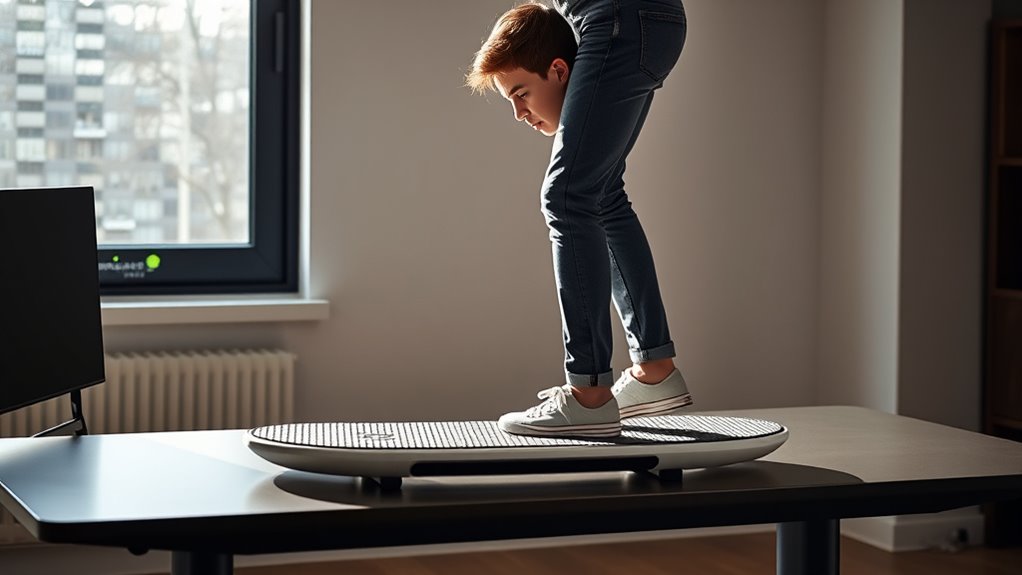
While balance boards can enhance your standing desk experience, they also introduce certain drawbacks and risks that you should consider. Using a balance board may require ergonomic adjustments to prevent strain or discomfort, especially if your posture shifts unexpectedly. It can also impact your workspace aesthetics, potentially making your setup look cluttered or less professional. The instability of some boards might increase the risk of falls or injuries, particularly if you’re new to balancing exercises. Additionally, prolonged use could cause fatigue in your legs or lower back if you don’t take regular breaks. Be mindful of your environment to make certain there’s enough space around your desk. Incorporating safety precautions and proper setup can help mitigate these risks and ensure a more secure experience. Weighing these potential risks against benefits helps you decide if a balance board fits your workspace and health needs.
How to Choose the Right Balance Board for Your Workspace

Choosing the right balance board for your workspace involves considering several key factors to guarantee comfort, safety, and compatibility with your setup. First, assess the size and shape of the board to ensure it fits comfortably in your available space and aligns with your ergonomic needs. Look for options compatible with your existing office equipment, like adjustable height or non-slip surfaces. Consider the material and stability to prevent accidents and ensure durability. Additionally, select a balance board that complements your ergonomic accessories, such as standing mats or footrests, for seamless integration. Your goal is to find a board that encourages movement without sacrificing comfort or safety, helping you stay active while maintaining proper posture during work hours. Incorporating market trends into your choice can also help you select a product that appeals to current ergonomic preferences and innovations.
Incorporating Balance Boards Into Your Daily Routine
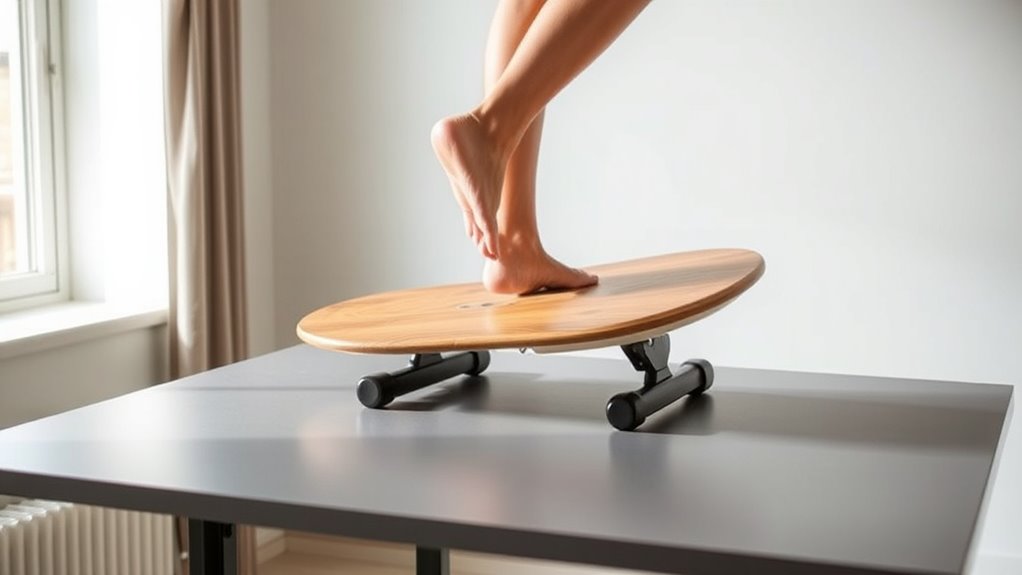
Integrating a balance board into your daily routine can considerably enhance your posture and increase movement throughout the workday. To maximize ergonomic benefits, start slowly by using the board for short periods, gradually increasing as your balance improves. Focus on maintaining proper alignment to avoid strain and guarantee safety precautions, like placing the board on a non-slip surface. Keep your feet shoulder-width apart and engage your core to stay stable. Incorporate balance exercises during breaks or when switching between tasks. Remember, mindful decluttering is essential for creating a workspace that supports focus and well-being. Keep in mind that consistency is key to seeing results. Be mindful of your comfort and stop if you experience pain or discomfort. With regular use and attention to safety, a balance board can become a valuable tool for promoting better posture and more active work habits.
User Experiences: What People Are Saying
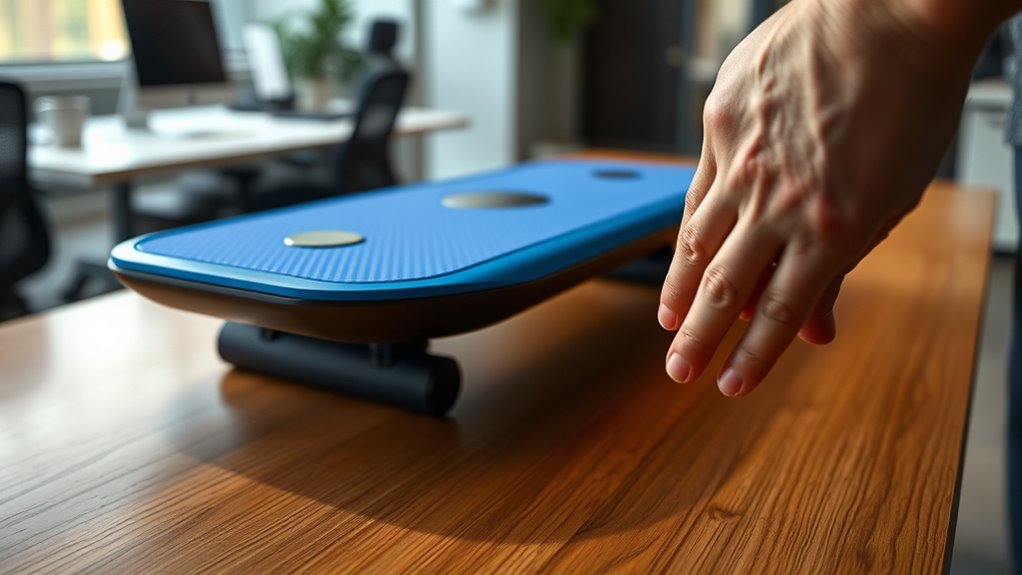
Many users report that incorporating a balance board at their standing desk has noticeably improved their posture and reduced discomfort during long work hours. They find it’s a helpful ergonomic accessory that promotes movement and stability. Some mention that balancing on the board makes them more aware of their desk organization, encouraging better cable management and workspace setup. Others say it helps break the monotony of standing still, boosting focus and energy. Here’s what users are saying:
| User Experience | Benefits | Challenges |
|---|---|---|
| Improved posture | Less back pain | Initial balance difficulty |
| Increased movement | Reduced fatigue | Learning to balance |
| Enhanced focus | Better desk organization | Adjusting to new routine |
| Boosted energy levels | More ergonomic setup | Finding the right board size |
| Reduced discomfort | Greater workspace comfort | Maintaining balance over time |
Adding a stability element can make the experience even more beneficial by enhancing core engagement.
Tips for Getting the Most Out of Your Balance Board

To maximize the benefits of your balance board, start by adjusting it to suit your height and workspace. Proper setup guarantees you maintain good posture and reduces strain, enhancing office wellness. Incorporate ergonomic accessories like foot pads or mats to stabilize your footing and prevent discomfort. Begin with short sessions to build balance and confidence, gradually increasing duration as you become more comfortable. Engage your core muscles to improve stability and prevent fatigue. Keep your workspace organized and clear of obstacles to avoid accidents. Alternating between balance exercises and regular standing breaks promotes better circulation and reduces fatigue. Using your balance board consistently helps develop core strength and improves posture, making it a valuable addition to your ergonomic accessories for a healthier, more active workday. Additionally, choosing a best free keto diet app can support your overall health goals while maintaining an active lifestyle.
Is a Balance Board a Must-Have for Standing Desk Users?

Is a balance board an essential tool for anyone using a standing desk? Not necessarily. While ergonomic accessories like balance boards can improve your posture and engage core muscles, they’re not a must-have for everyone. Your choice depends on your workspace setup and comfort needs. Some office furniture designs already promote movement and stability, making a balance board optional. If you find standing for long periods uncomfortable or want to add variety to your routine, a balance board can be a valuable addition. However, if you prefer a simple setup or have joint issues, it may be better to focus on ergonomic accessories that support proper alignment. Ultimately, it’s about finding what best complements your office furniture and enhances your productivity and well-being. Understanding ergonomic principles can help you determine the most suitable accessories for your needs.
Frequently Asked Questions
Are Balance Boards Suitable for All Age Groups?
Balance boards aren’t suitable for all age groups due to age appropriateness and safety considerations. Younger children and older adults may have difficulty maintaining balance, increasing the risk of falls or injuries. If you’re considering one, assess your own stability and consult a professional if needed. Always start with safety precautions and supervision, especially for vulnerable age groups, to guarantee a safe and beneficial experience.
How Long Should I Stand on a Balance Board Each Day?
You should start by standing on a balance board for about 5 to 10 minutes daily. This helps you enjoy the ergonomic benefits like improved posture and core strength. As you get used to it, gradually increase your time, but always prioritize safety precautions—listen to your body and avoid overdoing it. Remember, moderation guarantees you gain benefits without risking discomfort or injury.
Can Balance Boards Help Improve Overall Posture?
Think of your posture as a tall, sturdy tree. Using a balance board acts like nurturing its roots, strengthening core engagement and ankle stability. As you challenge your balance, you train muscles that support proper alignment, helping you stand taller and straighter. Over time, this practice can improve overall posture, making daily activities easier and reducing discomfort. Embrace the journey, and watch your body become more resilient and poised.
Do Balance Boards Require Special Maintenance or Cleaning?
Balance boards generally don’t require much maintenance, but you should follow basic cleaning tips to keep them in good shape. Wipe the surface with a damp cloth and avoid harsh chemicals to prevent damage. Check the non-slip pads and the board’s stability regularly. Maintenance requirements are minimal—just ensure the surface stays clean and dry, and inspect for any wear or loose parts to keep your balance board safe and effective.
Are There Specific Exercises to Maximize Balance Board Benefits?
Did you know that practicing specific exercises on your balance board can boost core engagement by up to 30%? To maximize benefits, focus on moves like single-leg stands and ankle circles, which enhance ankle stability and overall balance. Incorporate these into your routine regularly, maintaining proper posture and control. This targeted approach helps improve your stability, making daily activities easier and reducing injury risks over time.
Conclusion
So, after all this, maybe balance boards aren’t the miracle you hoped for—they might just turn your workspace into a mini circus act. While they add fun and challenge, don’t rely on them to replace good posture or regular movement. Ultimately, whether you love or hate it, a balance board probably won’t make or break your day—unless you’re aiming for a new Olympic sport at your desk. Keep balancing, or just sit back and enjoy the chaos.


